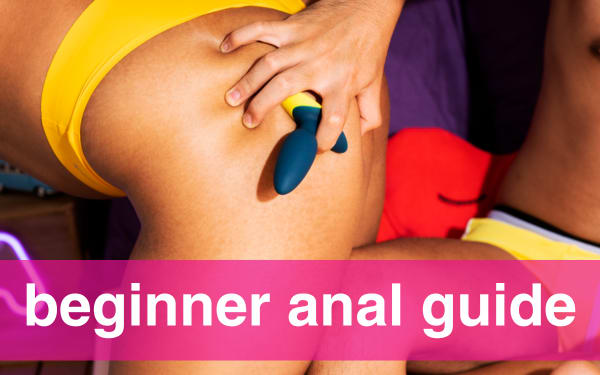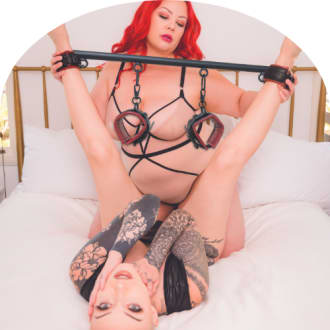How to Start Exploring BDSM
BDSM can be explored in many ways, so finding one good definition can often be tricky. One simple way to look at it is as a form of sensation play--you can create or receive various types of sensory exploration via types of touch, being bound, blindfolded, and more. But beyond all the whips and chains of kink is a basic (yet very broad) principle: playing with power exchange between partners. In this sense it’s just as mental as it is physical.
Cynthia Slater, a historic queer kinkster and activist, has referred to BDSM as the "consensual eroticized exchange of power," noting that each word in that sentence holds equal value. If it’s not consensual, it’s not BDSM / kink, and - more importantly - it’s not OK. There’s taking and yielding control through role play and/or action in a way that’s agreed upon by all parties for the sake of erotic or sexual pleasure.
What does BDSM stand for?

B: Bondage
Bondage: The act of restricting or restraining a partner.
Most commonly, bondage is used in reference to the act of tying someone up and/or restraining them with items such as cuffs or tethers. But in kink, just telling someone “Don’t move!” can also be considered a form of bondage.
D: Discipline / Dominance
Discipline: The act of setting rules with punishments for breaking them.
This often links Dominance and submission with sensation play, where the Dominant sets the expectations (or rules) for a submissive with consequences for breaking them - such as spanking or other impact play, humiliation, or other consensual “punishments”.
Dominance: The act of taking control or holding the power in a sexual scene or fantasy.
AKA, taking charge in an intentionally erotic way. The person who assumes the role of dominance is called the Dominant, Dom (neutral / masculine), or Domme / Domina (feminine) - these titles are always capitalized as a nod to authoritative respect.
S: Submission / Sadism
Submission: The act of yielding control or giving up the power in a sexual scene or fantasy.
AKA, letting yourself be taken charge of in an intentionally erotic way. The person who assumes the role of submission is called the submissive, or sub.
Sadism: The act of inflicting pain, humiliation, or intense sensation for erotic pleasure. If you like to serve up a spanking or watch your partner flinch with pleasurable discomfort or pain, that’s sadism. A person who enjoys this is called a sadist.
M: Masochism
Masochism: The act of enjoying pain, humiliation, or intense sensation for erotic pleasure.
Some people love it when it "hurts so good" - like hair pulling, biting, choking, or name-calling. So, if you’re someone who likes a little pain with their pleasure, you may be what is called a masochist.
Some other words to familiarize yourself with are top - the person leading the action, and bottom - the person receiving the action. (Note: not all tops are Dominant, and not all bottoms are submissive - top/bottom is about action and can refer to role, while Dom/sub is about power.)
Consent is always key.
BDSM often plays with a lot of power dynamics, so it’s extremely important to note that all of this exploration and play needs to be completely consensual, and something that is to the benefit and enjoyment of everyone involved.
Above all, BDSM is a practice of consent, communication, boundaries, and negotiation.
Safewords are essential
We could all learn a thing or two from the BDSM community. And one trick we wish everyone would use - whether we’re talking about serious kink or vanilla sex, or even navigating relationships outside of the bedroom - is the safeword.
A safeword is a word that conveys the need for a scene to be paused or stopped completely; a simple way to say that a boundary is being approached or crossed. We dive deeper into safewords - what makes a good safeword and how to use them - in this post.
Let’s talk about power
Power dynamics don’t have to be rigid. They can work on a spectrum. Is the exchange more about controlling the scene or the partner? Is the dominant person taking that role as more assertive or protective? Is the submissive one “pushing back” a bit, like being bratty, or are they playing a more service-oriented role? Set these expectations with your partner before you start playing during scene negotiation, and communicate throughout your play, checking in and using safewords if needed.
If both/all parties do not have a common ground of basic equality in the arrangement, then power cannot properly be exchanged. (This is why pretending your partner is your boss who says they’ll “give you that raise in exchange for sexual favors” works as a fantasy but would be problematic by someone who actually oversees your employment, since that power dynamic in the real world has a coercive nature.)
It’s about the exchange of power
When those big bad Doms make their sub get on their knees and lick their boots, it’s been pre-negotiated. A good Dom understands that submissive’s limits and desires from previous conversations and carefully facilitates a scene using them. And that submissive has the awareness of those limits and desires, shared them with their Dom, and is now getting their needs met.
Yes, that means that in order to be a good Dom - or a good sub - you have to be clear about boundaries. “Anything goes” does not a good BDSM scene make. “Do what you want to me” may sound submissive, but it doesn’t let the Top or Dom/me know what you want.
This is all to say that submissives also have true control in BDSM scenes, since their consent is pivotal. Everyone has an equal part in the agreement for mutual enjoyment, and consent can always be revoked by anyone regardless of their role in the power exchange of the scene.
Exploring the basics of BDSM
So, something about kink has piqued your interest. How do you start exploring?
First, figure out which of the letters we went into above is the one that caught your eye, and start researching. You can read erotica or watch some porn (keeping in mind that most porn is entertainment, not education - so you’re watching as inspiration, not as a guide), or dive into a how-to book to learn more about your topic of interest. Then, start slow.
Take your time
For a lot of folks, the intensity of kink and BDSM is what turns them on. But, in reality, what is considered “intense” differs from person to person. Our experiences, especially when it comes to physical experiences, are subjective and unique to our own bodies.
Consider this for impact play: what one person may consider a painful thwack with a paddle can be light work to another. Start gentle, and slowly build a cadence with more sensation as you go, communicating and checking in - both the top and bottom - throughout. Find your rhythm, and see what feels best, remembering to breathe and take breaks to let your body settle in.
When we’re aroused, our pain tolerance is increased, and so we really need to tune in to what our body is saying and the signals that it provides to us.
Use your body to practice
Of course, we LOVE bringing toys into the mix - the sting of a flogger and the restriction of a pair of restraints can feel incredible and add a whole new level of play, but if you’re not up to using those just yet - use your body first! Wrap your hands around your partner’s wrists to hold them down for a bondage-esque sensation. Use an open palm for a swift spank. We have a lot more control over our own bodies than we do with external tools, and knowing what works or doesn’t can make it easier to choose which kinky toy is your ideal when you’re ready to pick one out.
Aftercare
Like we’ve mentioned quite a few times, BDSM play can be pretty intense - and so it’s essential to take a moment after your scene is over to re-adjust to the real world and come down from the heightened state that the combination of arousal and kink can bring our minds into, whether or not there was obvious roleplay involved. Think of it as resetting your equilibrium.
At the risk of sounding like a broken record - but this is important, so we’re saying it anyway - everyone’s needs are different. Talk about what aftercare may look like for you before you start your scene, as a part of that pre-scene negotiation.
If there was a lot of intense physicality, maybe aftercare needs to include something like a massage, soft touch or cuddles, getting your partner a water or tea, rubbing lotion on a partner’s sore spots, or grabbing them a hot pack / ice pack to place on tender skin.
Go beyond the body
Aftercare isn’t just important for physical mending - it can be for reflective conversation, checking-in, and simply making sure each other's emotional needs are being cared for in that moment.
Some simple questions to ask in an aftercare check-in can be:
- How was that for you?
- Was there anything we did you’d like to explore again?
- Is there anything you want to change for the next time we play?
- (If a safeword was used) Can you talk to me about the boundary or trigger that made you use your safeword so we can avoid it in the future?
Also, keep in mind that for some, aftercare can mean needing space - and that’s perfectly valid, too. Just make sure that communication still happens at some point before you explore together again.
Ready to dive in?
Does this sound like a lot of information already? It can be! But that’s why we recommend digesting it all in small bite-sized nuggets vs a full dissertation - check out some of our posts on more specific topics of BDSM to explore below:


















